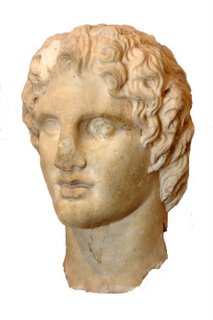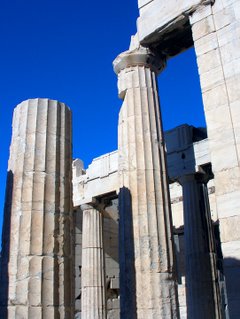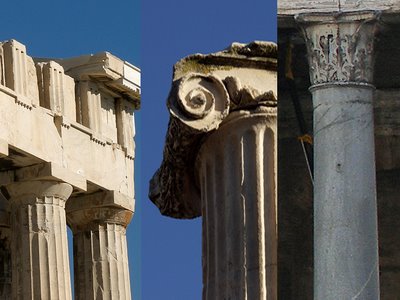
ATHENS AND THE PARTHENON

I was about to write that the Parthenon is the accepted icon of Western Civilization but suddenly remembered the golden arches and wondered if it’s still true. I can almost convince myself that the golden arches are the icon of just American Culture, but then I remind myself that a Macdonald’s in Moscow is the biggest and the busiest in the world, and that many people in the crowd I followed out of the train station in Amsterdam a few months ago were headed straight for a big mac a couple of blocks away. I remember seeing the golden arches in the Ginza in Tokyo on my first trip to Japan in 1969. The signs were there that Western Civilization was in trouble long before Iraq!
THE PARTHENON (in Greek:(Ο Παρθενώνας), a temple dedicated to the goddess Athena, was built in the 5th century B.C.E. on the acropolis of Athens. It is clearly the most famous surviving building of ancient Greece. No matter what 21st Century architects do to get our attention, there is little chance that anything will be designed soon that can eclipse this wonderful achievement of Greek architecture. I like Frank Gehry's Walt Disney Concert Hall in Los Angeles, but comparing it to the Parthenon is like comparing Botticelli's "Primavera" with a Jackson Pollack painting.

The building's decorative sculptures, most of which were long ago moved from Greece to places like the British Museum in London (Elgin Marbles, deposited there in 1816) are considered among the best examples of Greek art. The Parthenon is more than just an enduring symbol of Ancient Greece; it is a symbol of Athenian democracy. I find it interesting that in America we are still trying to determine what a perfect democracy might look like and whether or not democracy should be imposed on countries that don't have it.
The name of the Parthenon likely derives from the monumental cult statue of Athena Parthenos which was housed in the eastern room of the building. This statue was sculpted in ivory and gold by Phidias. Athena's epithet parthenos refers to the goddess's unmarried and virginal status.
 A decades-old war with Persia ended in 449 B.C.E. and a young democrat named Pericles began the most impressive program of public works in Greek history. Among his building projects was the Parthenon, which was meant as an expression of thanks to Athena by the people of Athens for saving the city from the Medes. The architect Phidias and others involved in designing the Parthenon produced a structure that is an optical illusion. They distorted the symmetry of the structure--bowing the sides out, canting the pillars in--to achieve a vision of geometric perfection. The building appeared to be squared and true when in fact it was composed of eye-deceiving curves.
A decades-old war with Persia ended in 449 B.C.E. and a young democrat named Pericles began the most impressive program of public works in Greek history. Among his building projects was the Parthenon, which was meant as an expression of thanks to Athena by the people of Athens for saving the city from the Medes. The architect Phidias and others involved in designing the Parthenon produced a structure that is an optical illusion. They distorted the symmetry of the structure--bowing the sides out, canting the pillars in--to achieve a vision of geometric perfection. The building appeared to be squared and true when in fact it was composed of eye-deceiving curves.
Today as then visitors approaching the Parthenon pass through the Propylaea, the main gateway to the citadel. Now the marble has aged to a honey color. Then it was gaudy with color and cluttered with commemorative steles and cult statues. Next to the Propylaea a little temple to Athena Nike was built to house the "Winged Victory" statue that now stands at the top of that grand staircase in the Louvre in Paris. Perched on the great southwest bastion, flanking the Propylaea, the little temple was one of the first buildings to catch a visitor's eye. Unfortunately, in 1686, the Turks dismantled it to make room for a gun emplacement.

After the Parthenon itself, my favorite building is the Erechtheum, a complex designed to house Athens' two great great deities, Athena and Poseidon, along with such Athenian nympths and folk heroes as Erechtheus, Cecrops, Boutes, and Pandrosos.

Statues of five junoesque women of Karyai in Laconia along one portal of the Erechtheum were recently moved inside to prevent further damage from pollution. Copies have been put in their place. They are known as the caryatids. They stand in silent regimentation on the south side of the building. They are said to be near-perfect reflections of the sense of order and self-restraint that characterized Athens during the first phase of the Peloponnesian War. The asymmetry of the Erecththeum contrasts sharply with the elegant balance of the adjacent Parthenon. The Erecththeum was erected thirty-two years after the Parthenon. The two nearly contemporary structures were different in function as well as in design. The great temple to Athena was a bold Doric building dedicated to the city's paramount deity; the Erechtheum, on the other hand, was created to honor not one cult statue but half a dozen. The structure, irregular in outline and ungainly in appearance, enclosed five shrines and two sacred precincts. The columns are Ionic on the Erechtheum and Doric on the Pantheon. The Doric capital has the simplest design; the Ionic has the curlicues called volutes, and the Corinthian has the acanthus leaves. The Corinthian column below is actually from a photograph I took of the Pantheon in Rome a few days after I was in Athens.

The modern cities of Athens and Pireus aren't living in the past. Commerce is brisk. I was able to find a battery charger for an Olympus camera (alas, made in Japan, not on Mount Olympus in Greece) without much of a search. I wandered into a couple of churches and found them to be no more or less active than a church you might enter in the middle of the week in San Diego.


3 comments:
Wow! I've never seen this view of the acropollius before. It's amazing how much grander and glory these old civilizations really had. I think I'll be posting a little musing of this on my blog next week. Looks like you had a great trip!
Jesse,
Over the next few years get your ducks in a row so you can spend some time in places like Athens and Rome. I can't think of anybody who is better suited for those places.
Jerral
Definitely! I will go sometime. BTW, maybe even this summer. I'm going to be taking Russian III in the Spring and my Mother says perhaps I can go to Russia over the summer. That means some stops over there in Europe. Rome would be a good choice. We young people really need to learn a lot more about these achient cultural sites. Not only in Europe, but all over. There is soooooo much history in Asia that is virtually forgotten by us Europeans. China has had a recorded history for thousands of years, but society knows virtually nothing of it. Not to mention the cultural sites and even the legends and tales from Europe that we have seemingly forgotten. The tales of the Rhine, viking folk tales, ballads from England. I don't understand it with society, but even a lot of people here at Grossmont College don't even know of the major works like El Cid, Beawolf, Song of Roland and a host of others. Perhaps if the schools would take like a full semester and travel, it would revive our lost love of learning, especially of history and culture.
Post a Comment